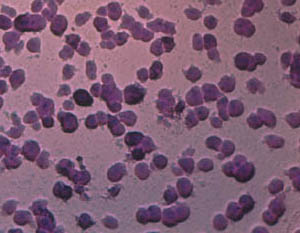

| Thermophilic Aerobes and "Growth history" |
| Fourty years ago, when I started my work in the sugar industry in the field of microbiology, a slide culture method was common practice in Austrian sugar factories. The method was used to count aerobic micro-organisms in undiluted juice samples drawn from the extraction process. It had been introduced in 1957, in order to get results more quickly (after 5 hours), compared to conventional plate counts (one day). In studies done from 1965 to 1968 we tried to compare this slide culture method with the conventional plate count method, but without success. The background was as follows: |
 |
Bac. stearothermophilus germs, stemming from aerobic growth history (e.g. DDS extraction trough or growth in presence of nitrate) will grow like buttons in a subsequent aerobic slide culture, as visible in this upper picture. These colonies can easily be counted and micro-organisms growing like these are less sensitive to sample dilution, compared to those from anaerobic conditions. |
 |
Bac. stearothermophilus germs, stemming from anaerobic growth (e.g. from a tower extraction at mid-tower position) will grow as visible in the second picture in a subsequent aerobic slide culture. Although growing bad on the aerobic slide, they cause a heavy conversion of sugars to acid in the tower. With anaerobic history the germs will not survive a dilution step and especially a multi-step dilution for conventional plate counts. |
|
The sugar factory Enns in the province of Upper Austria was operated with one tower and one DDS trough in parallel, with the same beet material for both, at that time. So we had the best conditions to study the influence of aerobic and anaerobic "growth history" on a subsequent aerobic incubation. A multi-step dilution of hot juice from the extraction tower was necessary for the conventional plate counts and the bacteria lost their colony forming properties after dilution. Replacement of the classical diluting agent (NaCl solution, 9 g/L) by sterile liquid nutrient could not prevent a nearly total loss of CFU (colony forming units) in diluted samples, but the "bad growing units" were visible in the slide culture and there was a logical correlation between number of "bad growing units" and acid formation. Due to the problems with sample dilution, we eliminated a tenfold dilution, which was sometimes necessary for the original slide culture method, by reducing the sample volume from 100 μL to 10 μL. But after having made this bad experience with sample dilution, we no longer trusted figures for thermophiles from conventional plate counts, if published in scientific papers by other authors. |
| 2005-01-16 G. Pollach |
 |